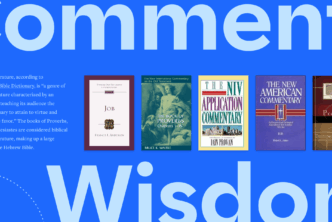The tree of life represents the fullness of eternal life that God wishes to lavish on humanity. It’s one of the most powerful images in God’s Word, extending from the first chapters of Genesis to the final ones of Revelation.
Of the three most important events in the Bible—creation, the death and resurrection of Jesus, and the new creation described in Revelation 21–22, you’ll find this tree in at least two of those scenes. Some say it’s in all three.
Here we’ll dig deeper into the Old and New Testament pictures of the tree of life to help us understand more of what these images mean.
The tree of life in the Old Testament

The tree of life appears seven times in the Hebrew Bible, but only in Genesis and Proverbs. Genesis 2:9 introduces the tree of life as one of two trees in the Garden of Eden. God commanded Adam and Eve not to eat from the other tree, the Tree of the Knowledge of Good and Evil (Genesis 2:16).
But God gives no such prohibition for the tree of life. It’s (apparently) among the trees that God tells the first couple they are free to consume. Everything changes when Adam and Eve eat from the tree of the knowledge of good and evil. Because of this act of disobedience, God exiles the couple from the garden, specifically to keep them away from the tree of life, which the Lord ties to eternal life.
The Lord God said, “Since the man has become like one of us, knowing good and evil, he must not reach out, take from the tree of life, eat, and live forever.” So the Lord God sent him away from the garden of Eden to work the ground from which he was taken. He drove the man out and stationed the cherubim and the flaming, whirling sword east of the garden of Eden to guard the way to the tree of life. (Gen 3:22–24)
God then stations cherubim with flaming swords in front of the tree to protect it. In his book Creation and Fall, German theologian Dietrich Bonhoeffer describes the tree of life as a central part of the Genesis creation story:
The whole story moves toward its end in these verses (Gen 3:22–24). … Indeed it becomes plain that the whole story has really been about this tree.1
The book of Proverbs references the tree more generically, as “a” tree of life. Proverbs 3:13–18 describes a man who is happy that he has found wisdom, extolling many of the benefits of wisdom in our lives (including profit, long life, and honor). Then the proverb says,
She [Wisdom] is a tree of life to those who embrace her,
and those who hold on to her are happy. (3:18)
Duane Garrett suggests that the author of this proverb uses the tree of life as a metaphor that reinforces the joy found in a life of wisdom. But he notes that it also has deeper implications beyond mere happiness. Because of the long-held biblical and Near East roots of the tree of life, Garrett believes, “The words hold the promise of escape from the curse of death.”2
The other references to the tree in Proverbs are decidedly less symbolic and instead more metaphorical. Proverbs 11:30 compares “the fruit of righteousness” to a tree of life. Proverbs 13:12 relates “a desire fulfilled” to the tree of life. Proverbs 15:4 likens healing words to a tree of life—as opposed to a “devious tongue” that “breaks the spirit).”
Some Old Testament scholars believe the “tree planted beside flowing streams,” described in Psalm 1, refers back to the tree of life from the creation story.
While the Bible’s descriptions of the tabernacle and the first temple do not specifically mention the tree of life, several elements of those places of worship allude to it. The menorah placed in the tabernacle was possibly seen as a metaphor for the tree of life. We’re also told that the walls of Solomon’s temple contained images of trees and cherubim (see 1 Kgs 6:23–35), perhaps also referring back to the Garden of Eden.
In addition to Scripture, it is important to recognize that the Ancient Israelites were familiar with this concept, even beyond what the Bible says.
In the ancient Near East, a tree of life is a common motif representing humanity’s quest for immortality. The ancient readers of the book of Genesis would have likely understood the tree of life to be associated with some form of eternal or perpetual life.3
The tree of life was a powerful symbol in ancient Israel for the abundant, eternal life that God intended for humans. The Old Testament reflects that understanding.
The tree of life in the New Testament
The references to the tree of life in the New Testament all appear in Revelation, and all clearly connect back to the image from the Garden of Eden in Genesis 2–3.
We first see the image of the tree of life as John describes the letters to the seven churches in Revelation 2–3. In the letter to the church of Ephesus, John writes:
Let anyone who has ears to hear listen to what the Spirit says to the churches. To the one who conquers, I will give the right to eat from the tree of life, which is in the paradise of God. (Rev 2:7)
The tree of life is the reward for Jesus-followers who overcome worldly persecution. Most commentators suggest that this reward is the presence of God (and immortality) that Adam and Eve had before the Fall in Genesis 3.
Another reference to the tree of life in the New Testament comes at the end of the book of Revelation, providing a powerful bookend to the biblical story. In Revelation 21–22, the Apostle John gives us a striking picture of the final destination of humanity, describing a new Jerusalem on a new earth, a place where all of God’s people will live. In this celestial city, Jesus himself will be the lamp and God’s glory will illuminate the entire city (Rev 21:23). The nations of the earth will bring their glory and honor into the city (v. 26).
And at the center of the city, the tree of life will straddle the city’s great river. The tree represents the overturning of the Genesis 3 curse.
The leaves of the tree are for healing the nations, and there will no longer be any curse. (Rev 22:2–3)
In Genesis 3, God exiled humanity from paradise so they could no longer eat from the tree’s fruit. Now humanity would forever have access to its life-giving fruit.
What is the tree of life’s meaning?
So what does this mysterious tree of life, which shows up at the beginning and the end of the biblical story, mean? And does it have any relevance for those who want to live out a vibrant Christian faith today?
The tree of life represents an eternal, life-giving relationship with God, one that the first Adam forfeited access to with his disobedience (Rom 5:12).
Some biblical interpreters throughout the centuries have suggested that the tree has magical properties to it, suggesting that “the eating of this fruit would produce immunity from disease either by one dose or by continuous partaking.”4
But the physical properties of the tree are beside the point. God himself tells us what the tree means when he casts Adam and Eve out of the garden:
The Lord God said, “Since the man has become like one of us, knowing good and evil, he must not reach out, take from the tree of life, eat, and live forever.” (Gen 3:22)
The tree is about eternal life—which now every one of us has access to thanks to what happened upon another tree on a hill called Calvary.
It’s no accident that John tells us, “There was a garden in the place where [Jesus] was crucified” (Jn 19:41).
Just like the first garden had a tree that brought life, the second garden had one too. Through Jesus’s death on that tree and his resurrection three days later, we all have access to eternal life.
Charles Spurgeon, the great nineteenth-century “Prince of Preachers,” once took the analogy a step further, preaching Jesus as the tree of life.
We believe our Lord Jesus Christ to be none other than that tree of life, whose leaves are for the healing of the nations. We can scarcely conceive of any other interpretation, as this seems to us to be so full of meaning, and to afford us such unspeakable satisfaction. At any rate, beloved, if this be not the absolute purpose of the sublime vision that John saw, it is most certainly true that our Lord Jesus Christ is life from the dead, and life to his own living people. He is all in all to them; and by him, and by him alone, must their spiritual life be maintained.5
The tree of life isn’t just an image in the Bible. It doesn’t just represent immortality. The tree of life is a promise. It reminds us that one day God will make everything right again. And the nations, broken throughout history, will find healing.
Related articles
- What Happened on the 7 Days of Creation?
- Every Person an Icon: Why Creation Signifies Dignity for All
- Why Did Jesus Curse a Fig Tree?
- Ingrid Faro, “Tree of Life,” ed. John D. Barry et al., The Lexham Bible Dictionary (Bellingham, WA: Lexham Press, 2016).
- Duane A. Garrett, Proverbs, Ecclesiastes, Song of Songs, vol. 14, The New American Commentary (Nashville: Broadman & Holman Publishers, 1993), 82.
- Ingrid Faro, “Tree of Life,” ed. John D. Barry et al., The Lexham Bible Dictionary (Bellingham, WA: Lexham Press, 2016).
- E. B. Smick, “Tree of Knowledge,” ed. Geoffrey W. Bromiley, The International Standard Bible Encyclopedia, revised (Wm. B. Eerdmans, 1979–1988), 902.
- C. H. Spurgeon, “Christ the Tree of Life,” in The Metropolitan Tabernacle Pulpit Sermons, vol. 57 (London: Passmore & Alabaster, 1911), 241–242.








